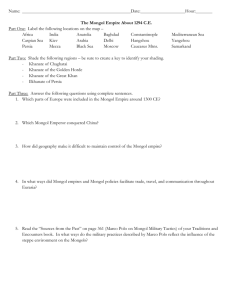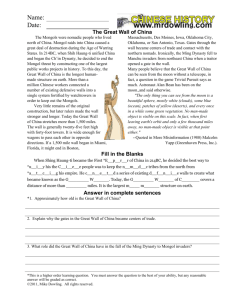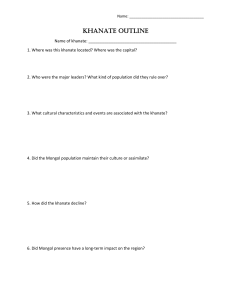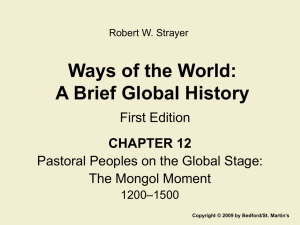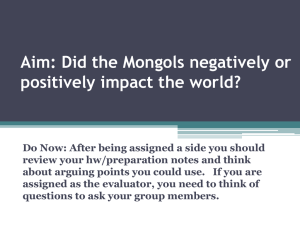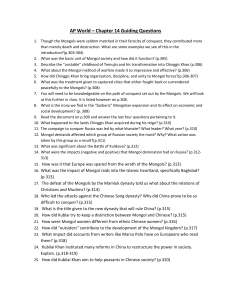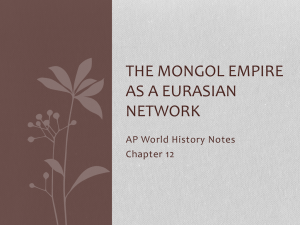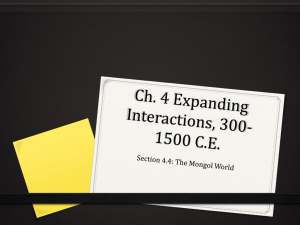WHAP Chapter 11 Reading Guide
advertisement
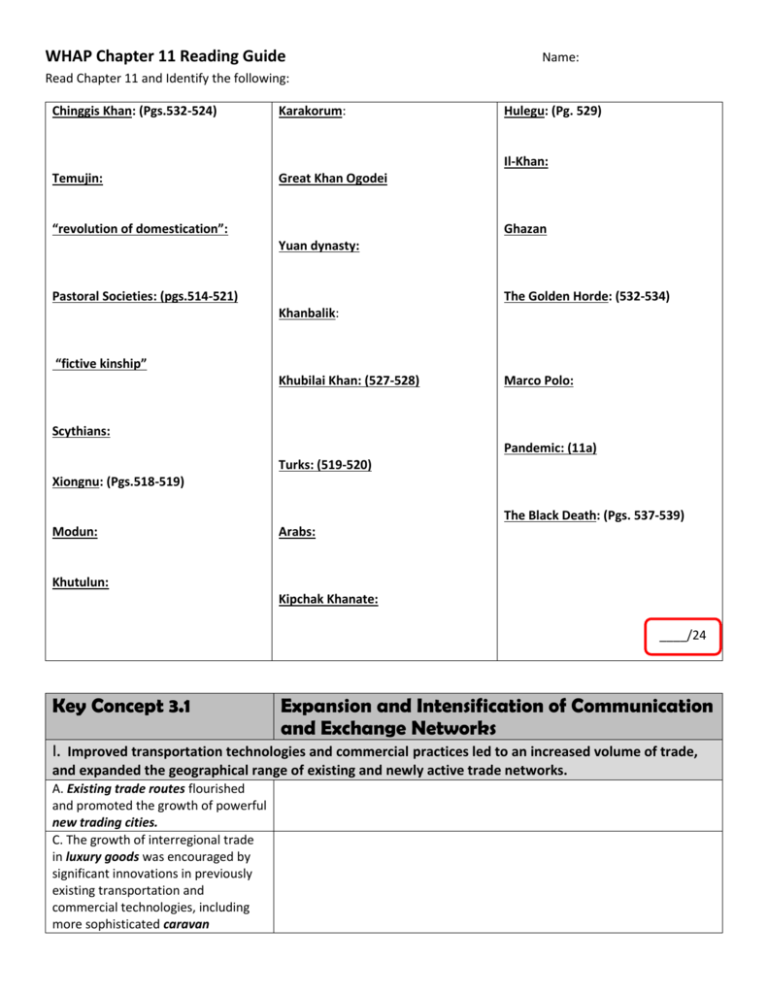
WHAP Chapter 11 Reading Guide Name: Read Chapter 11 and Identify the following: Chinggis Khan: (Pgs.532-524) Karakorum: Temujin: Great Khan Ogodei Hulegu: (Pg. 529) Il-Khan: “revolution of domestication”: Ghazan Yuan dynasty: Pastoral Societies: (pgs.514-521) The Golden Horde: (532-534) Khanbalik: “fictive kinship” Khubilai Khan: (527-528) Marco Polo: Scythians: Pandemic: (11a) Turks: (519-520) Xiongnu: (Pgs.518-519) The Black Death: (Pgs. 537-539) Modun: Arabs: Khutulun: Kipchak Khanate: ____/24 Key Concept 3.1 Expansion and Intensification of Communication and Exchange Networks I. Improved transportation technologies and commercial practices led to an increased volume of trade, and expanded the geographical range of existing and newly active trade networks. A. Existing trade routes flourished and promoted the growth of powerful new trading cities. C. The growth of interregional trade in luxury goods was encouraged by significant innovations in previously existing transportation and commercial technologies, including more sophisticated caravan organizations; use of the compass, astrolabe, and larger ship designs in sea travel; and new forms of credit and monetization. D. Commercial growth was also facilitated by state practices, trading organizations, and state-sponsored commercial infrastructures. E. The expansion of empires facilitated Trans-Eurasian trade and communication as new peoples were drawn into their conquerors’ economies and trade networks. II. The movement of peoples caused environmental and linguistic effects. A. The expansion and intensification of long-distance trade routes often depended on environmental knowledge and technological adaptations to it. C. Some migrations and commercial contacts led to the diffusion of languages throughout a new region or the emergence of new languages. III. Cross cultural exchanges were fostered by the intensification of existing, or the creation of new, networks of trade and communication. C. The writings of certain interregional travelers illustrate both the extent and the limitations of intercultural knowledge and understanding. D. Increased cross-cultural interactions resulted in the diffusion of literary, artistic, and cultural traditions. E. Increased cross-cultural interactions also resulted in the diffusion of scientific and technological traditions. IV. There was continued diffusion of crops and pathogens throughout the Eastern Hemisphere along the trade routes. A. New foods and agricultural techniques were adopted in populated areas. B. The spread of epidemic diseases, including the Black Death, followed the well-established paths of trade and military conquest. Key Concept 3.2 Continuity and Innovation of State Forms and Their Interactions I. Empires collapsed and were reconstituted; in some regions new state forms emerged. B. In some places, new forms of governance emerged; including those developed in various Islamic states, the Mongol Khanates, city-states, and decentralized government (feudalism) in Europe and Japan. Pastoral societies: C. Some states synthesized local and borrowed traditions. China: Mongols: Persia: II. Interregional contacts and conflicts between states and empires encouraged significant technological and cultural transfers Across Mongol empires: - Maybe “encouraged” isn’t the word. Mongols forced areas to submit. If they wanted to trade and you didn’t, you could be decimated. - Islam- Some ideas from Mongols did not spread and they did not force their culture on those they conquered. - Farming from Persians - Some language transfer to Mongols from conquered places Key Concept 3.3 Increased Economic Productive Capacity and Its Consequences I. Innovations stimulated agricultural and industrial production in many regions. A. Agricultural production increased significantly due to technological innovations such as? B. In response to increasing demand in Afro-Eurasia for foreign luxury goods, crops were transported from their indigenous homelands to equivalent climates in other regions. II. The fate of cities varied greatly, with periods of significant decline, and with periods of increased urbanization buoyed by rising productivity and expanding trade networks. A. Multiple factors contributed to the declines of urban areas in this period. B. Multiple factors contributed to urban(city) revival. Trade? Almoravid Empire (Marrakesh) - C. While cities in general continued to play the roles they had played in the past as governmental, religious, and commercial centers, many older cities declined at the same time that numerous cities emerged to take on these established roles. cities declined: cities emerged: III. Despite significant continuities in social structures and in methods of production, there were also some important changes in labor management and in the effect of religious conversion on gender relations and family life. A. As in the previous period, there were many forms of labor organization. B. As in the previous period, social structures were shaped largely by class and caste hierarchies. Patriarchy persisted; however, in some areas, women exercised more power and influence. C. New forms of coerced labor appeared. Free peasants resisted attempts to raise dues and taxes by staging revolts. The demand for slaves for both military and domestic purposes increased, particularly in central Eurasia, parts of Africa, and the eastern Mediterranean. D. The diffusion of Buddhism, Christianity, Islam, and NeoConfucianism often led to significant changes in gender relations and family structure. In pastoral societies: Women: Kinship: Religions that impacted Mongol rule and how? ____/22 Chapter 11 Big Questions: Complete Short Essays Required (2-4 sentences) 1. In what ways did the pastoral societies differ from their agricultural neighbors and how did they interact? 2. What accounts for the often attitudes of settled societies toward the pastoral people living on the borders? 3. How did the Xiongnu, Arabs, Turks, and Berbers make an impact on world history? 4. What accounts for the political and military success of the Mongols? 5. How did the Mongol rule affect the Islamic world, Russia, China, Persia, and Europe? 6. How did the Mongol rule impact and change China? 7. What does the life of Khutulun reveal about Mongol gender relationships? (Page 530-531) 8. How do documents 11.1 and 11.2 help explain the success of Mongol rule and their view of conquered people? 9. According to document 11.3, what aspects of Mongol rule offended the Russian people? 10. *How would you describe the core values of Mongol culture? (Consider their leaders, goals, attitudes toward conquered people, duties of rulers, role of women, etc...) Where these values eroded as the empire spread and changed hands?(1/2 Page Response Required) The Mongol Empire Mapping Exercise - (Page 522) Step 1: Outline and Color the Khanate of the Golden Horde, The Great Khanate, Il-Khanate of Persia, Khanate of Jagadai, and Mongol homeland. Step 2: Outline with a red pencil the extent of the Mongol Empire by 1279. Step 3: Label the following regions: Siberia, Russia, Egypt, Arabia, India, Burma, Vietnam, Korea, Japan, China, Sumatra, Java, Italy, Anatolia, Europe, and Syria. Step 4: Label the following bodies of water: Pacific Ocean, Indian Ocean, Red Sea, Mediterranean Sea, South China Sea, Black Sea, Caspian Sea, and Bay of Bengal.
